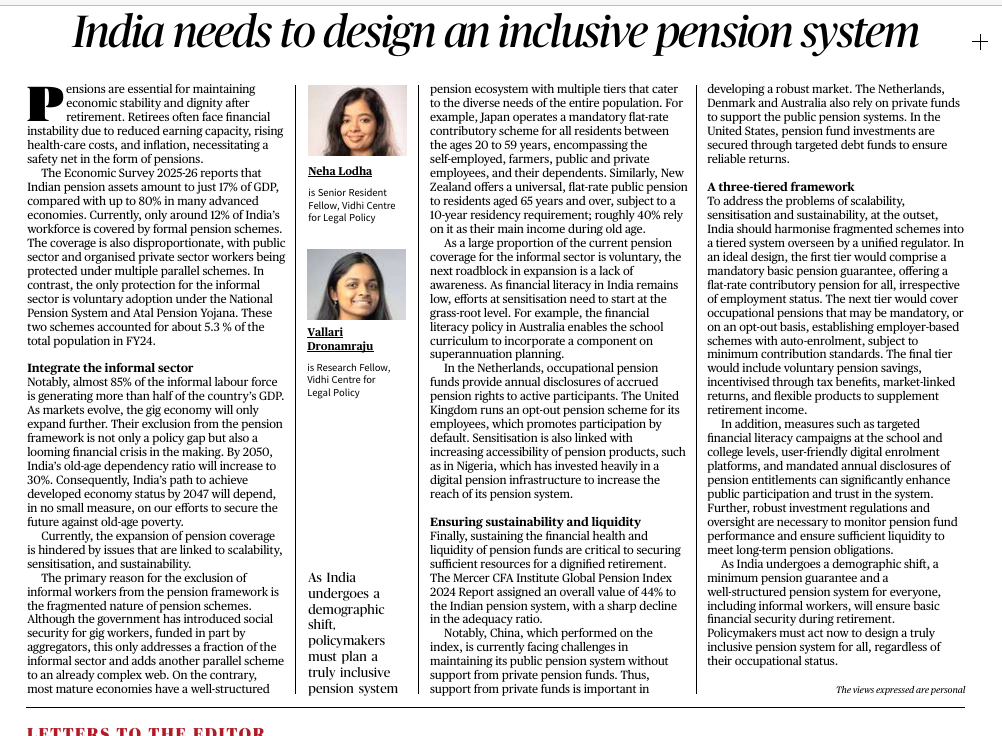I. Context and Background
- With rising life expectancy, high out-of-pocket healthcare costs, and inflation, old-age income security is becoming increasingly critical.
- India’s current pension architecture is highly fragmented, inadequate, and skewed toward the formal sector, leaving a large portion of informal and gig workers without retirement security.
- The editorial calls for designing an inclusive, unified, and sustainable pension system that integrates the informal workforce and ensures universal basic income in old age.
II. Key Issues Raised
1. Low Pension Coverage and Assets
- India’s pension assets account for only 17% of GDP, compared to 60–80% in developed economies.
- Only 12% of India’s workforce is covered under formal pension schemes.
- Two major voluntary schemes for informal workers (National Pension System and Atal Pension Yojana) cover just 3% of the population in FY24.
Implication: This leaves millions vulnerable to old-age poverty, with serious macroeconomic and social implications.
2. Need to Integrate Informal Sector
- Nearly 85% of India’s labour force is informal and contributes over half of GDP.
- Exclusion of this group from the pension net reflects a major policy and financial crisis in the making.
- With the old-age dependency ratio set to reach 30% by 2050, securing this segment is critical for India’s 2047 developed economy ambitions.
3. Key Challenges
- Scalability: Fragmented schemes and lack of universal mandates make the system inefficient.
- Sensitisation: Workers are unaware or reluctant to join voluntary pension programs.
- Sustainability: Lack of long-term investment standards and limited regulation jeopardise financial returns and pension payouts.
Current Framework Weaknesses:
- Parallel schemes for formal workers (e.g., EPFO, NPS) vs. voluntary opt-in schemes for others.
- Absence of a mandatory basic pension floor.
III. Global Models and Lessons
- New Zealand: Offers a universal flat-rate pension for all citizens above 65, irrespective of income.
- Australia: Enforces mandatory superannuation contributions, with school-level financial education.
- US, Netherlands, Denmark: Rely on a mix of public and private pension funds, regulated and diversified for stability and returns.
Implication: India must develop a mixed pension market with both public guarantees and private participation.
IV. Author’s Policy Recommendations
A. Three-Tiered Pension Architecture
- Tier 1: Basic Pension Guarantee
- Flat-rate benefit for all citizens, regardless of employment status.
- Tier 2: Occupational/Employer-based Pension
- Either mandatory or opt-out basis.
- Includes defined contribution plans (e.g., NPS), regulated by a unified pension authority.
- Tier 3: Voluntary Pension Savings
- Incentivised by tax breaks, subsidies, or flexible withdrawal options.
B. Support Mechanisms
- Robust regulation and investment oversight to ensure long-term sustainability.
- Targeted awareness campaigns at grassroots and school levels.
- Mandated disclosures to build trust and improve public participation.
- Inclusion of gig economy and informal sector via aggregators or digital platforms.
V. Strategic Importance
- A comprehensive pension policy ensures:
- Dignified retirement
- Financial resilience of elderly populations
- Macro-economic stability amid demographic transition
- Dignified retirement
- It also aligns with the goals of a developed India by 2047, especially as the elderly population share increases rapidly.
VI. Conclusion
The editorial stresses that India’s pension system needs a paradigm shift — from fragmented, formal-sector-focused models to a universal, inclusive, and sustainable framework. Policymakers must now act decisively to create a robust pension net that secures the future of both formal and informal workers alike.


